The Thai Micro Crab is one of our miniature crabs. It is an excellent addition to any nano or planted aquarium and can even be kept in a bowl or jar on your desktop.
They also look fantastic and are a lot of fun to watch. This is one of the most carefree crabs you can keep, and it is hard to wrong with it, but you should know a few things to ensure your Thai Micro Crab lives long and healthy.
This guide will cover everything you need to know about the Thai Micro Crab, its diet, habitat, tank mates, and more. So, if you consider adding to your aquarium, keep reading.
Table of Contents
- Thai Micro Crab: Species Summary
- Thai Micro Crab: Behavior & Temperament
- Thai Micro Crab: Breeding
- Thai Micro Crab: Food & Diet
- Thai Micro Crab: Care
- Thai Micro Crab: Tank Size
- Thai Micro Crab: Water Parameters
- Thai Micro Crab: Water Changes
- Filtration
- Heater
- Lighting
- Aquarium Decor
- Thai Micro Crab: Other Tank Accessories
- Thai Micro Crab: Aquarium water conditioner
- Thai Micro Crab: Cleaning The Tank
- Thai Micro Crab: Common Possible Diseases
- Thai Micro Crab: Treatment & Medications
- Thai Micro Crab: Tank Mates
- Advantages Of Having Thai Micro Crab In Your Tank
- Disadvantages Of Having Thai Micro Crab In Your Tank
- Conclusion
Thai Micro Crab: Species Summary
| Scientific name: | Limnopilos naiyanetri |
| Common Name: | Thai Micro Crab |
| Family: | Hymenosomatidae |
| Size: | Up to 0.5 inch |
| Temperament: | Peaceful, but can be nippy if not well fed |
| Tank size: | 6 gallons |
| Compatibility: | Excellent |
| pH range: | 6.5 – 7.3 |
| Water hardness: | 5 – 10 dKH |
| Temperature Range: | 70° – 82° Fahrenheit |
| Water Type: | Freshwater |
| Nature: | Semi-Aquatic |
| Lifespan: | 1-2 years |
| Care Level: | Easy |
| Origin: | Thailand |
| Food: | Omnivorous |
These freshwater crabs can be found in the muddy shallows of Southeast Asia. Thai Micro Crabs are peaceful crabs but can become nippy if not well-fed.
Thai Micro Crab: Appearance
If you are like most people, you will want to get a Thai Micro Crab because they look fantastic. And you would be right- these little guys are a sight.
Their silvery-gray shell and translucent legs add a lot of personality to any tank. They also swim around quite a bit, so you will always have something to watch.
They have a circular body known as a carapace, and their legs are beige-like. Typically, these crabs are silvery-white with a few black spots on their carapace.
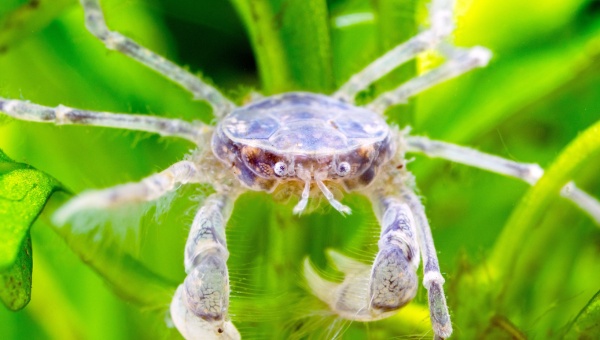
Their ten legs are long, spindly, and transparent grey /silvery in color. When fully grown, they will have a length of 1 cm.
However, most of their personality comes from their big, round eyes, which are black. The exciting thing about their eyes is that they can move independently so that the crab can simultaneously look in two different directions.
They have tiny hairs on their legs that are visible to the naked eye. These hairs are used for sensing movement and touch. Their hair also catches food particles in the water. They can grab things with their front legs and manipulate objects with pincers.
Thai Micro Crab: Size & Growth Rate
The Thai Micro Crab carapace averages growth of about 1 cm in size, and its leg size is about 2.5cm, but it can grow slightly more prominent. They will reach their full size within a few months of being added to your tank.
These critters are slow growers, so you will not have to worry about them taking over your tank. Thai Micro Crabs undergo a molting process just like any other crab.
Thai Micro Crab: Lifespan
The average Thai Micro Crab lifespan is around 1 to 2 years. However, with proper care, they can live a little longer.
It’s worth pointing out that most crabs in the wild do not live beyond two years, so your Thai Micro Crab will be doing well if it makes it to three years.
Thai Micro Crab: Behavior & Temperament
Thai Micro Crabs are very active and playful crabs. They love to explore their environment and will climb all over the tank. They are also very social crabs and love to interact with their owners.
Thai Micro Crabs have an excellent temperament, and they are rarely aggressive. However, they may pinch if they are mishandled.
For these crabs, hiding is crucial; they would do anything to have a place to hide. Please provide them with different types of rocks, caves, plants, and other things to hide in. Don’t be surprised if your Thai Micro Crabs climb all over you when you are near the tank. They love to explore their environment, and they love to socialize with their owners.
Thai Micro Crab: Breeding
Unfortunately, Thai Micro Crab breeding is unsuccessful, as the baby crabs do not survive a week after hatching. Also, baby crabs are sometimes eaten by the male crab.
In Thai Micro Crabs, fertilization occurs internally, and sperm is transferred from the male gonopod to the female. Female stores 200 eggs into her pleon after fertilization until the eggs hatch.
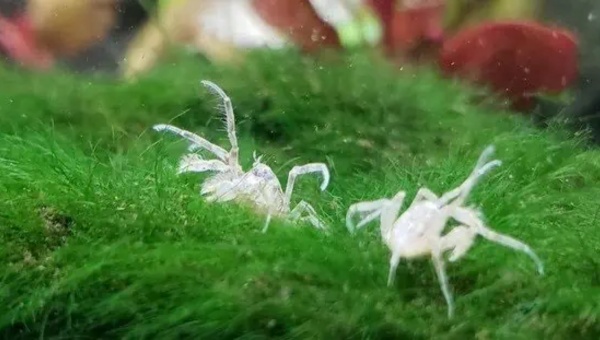
The female carries the babies in their larval condition until their grown state, where they can survive independently. If released into the environment in the larval condition, they will not survive the brackish water or the water condition and can also be eaten alive by fish and other male crabs.
Thai Micro Crabs do not successfully breed in captive conditions but thrive in their natural habitat.
Thai Micro Crab: Food & Diet
Thai Micro Crabs is omnivorous and need a varied diet to stay healthy. They should be fed fresh vegetables, fruits, and pellets or sticks specifically for crabs.
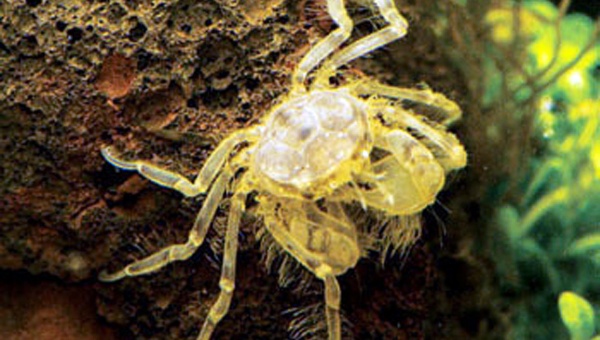
Some good food options for Thai Micro Crabs are:
- Romaine lettuce: This is a good source of fiber and vitamins.
- Carrots: This is a good source of beta carotene, which the crab can convert to vitamin A.
- Celery: This is a good source of water and minerals.
- Apple: This is a good source of Vitamin C.
- Crab pellets or sticks: These are specifically for crabs and contain various nutrients that the crab needs.
- Green beans: These are a good source of protein and vitamins.
- Zucchini: This is a good fiber, water, and vitamin source.
You can also give your Thai Micro Crabs live food options, such as:
- Daphnia: This is a small crustacean that is high in protein.
- Bloodworms: These are red worms that are high in protein and minerals.
- Mosquito larvae: These are high in protein and vitamins.
- Algae wafers: These are high in fiber and vitamins.
You should always consult a veterinarian if you are unsure how to feed your Thai Micro Crabs.
Thai Micro Crab: Diet Foods To Avoid
There are some foods that you should avoid feeding your Thai Micro Crabs. These foods can be harmful to the crab and can cause health problems.
Some of the diet foods to avoid are:
- Uncooked meat: This can cause bacterial infections in the crab.
- Sugar: This can cause health problems in the crab.
- Junk food: This is high in fat and calories and can lead to obesity.
You should consult a veterinarian if you are unsure how to feed your Thai Micro Crabs.
Thai Micro Crab: Care
Thai Micro Crab care is effortless; even a beginner can handle them. One of the main reasons they are so easy to keep is that they do not require a specific water pH or hardness.
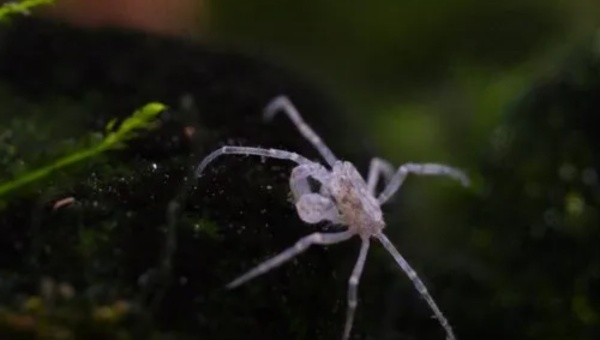
They are low-maintenance crabs and can be kept in a wide range of water temperatures. They’re not like other crabs that require brackish or marine water.
Of course, these creatures are best kept in a freshwater tank but can also live in slightly brackish water. If your aquarium is saltwater, you should not add any salt to the water.
Below are the basic requirements for keeping a Thai Micro Crab.
Thai Micro Crab: Tank Size
The Thai Micro Crab can be kept in a tank as small as 6 gallons, but it will do much better in a tank much larger than the average size.
A bigger tank means more space for the crab to swim and play. It also makes it easier to keep the water clean.
These crabs are great for beginners because they do not require a lot of space. A small group of five or six can be kept in a 15-gallon tank.
Thai Micro Crab: Water Parameters
As with any other aquarium inhabitant, the water parameters in your tank should be within the acceptable range for Thai Micro Crabs. Using a quality aquarium water test kit is the best way to keep your water parameters in check.
The following water parameters are the ideal range for Thai Micro Crabs:
- pH level: The pH level of your tank should be between 6.5 to 7.3
- Ammonia: The ammonia level in your tank should be 0 ppm
- Nitrite: The nitrite level in your tank should be 0 ppm
- Nitrate: The nitrate level in your tank should be below 20 ppm
- Water temperature: The water temperature in your tank should be between 70° to 82° Fahrenheit
- Water Hardness: The water hardness in your tank should be below 10 dKH
Thai Micro Crab: Water Changes
A water change should be done weekly to keep the water parameters in check.
You must take corrective action if your water parameters are not within the acceptable range.
If the pH level is too high or too low, add a pH adjuster to the tank. If the ammonia level is too high, you must do a water change. And if the nitrite or nitrate levels are too high, add a water filter or water purification tablets.
Filtration
The best way to keep the water in your tank clean is to use a quality aquarium filter. A good filter will help to remove ammonia, nitrite, and nitrate from the water.
Thai Micro Crabs can also be kept in a filtered aquarium. If you keep them in a saltwater tank, you must use a marine aquarium filter.
Some of the famous Snowball Pleco Filters are:
- The Fluval 405: These filters are an excellent choice for tanks up to 55 gallons. They have a three-stage filtration system that helps to keep the water clean and clear.
- The Eheim 2217: This filter is an excellent choice for tanks up to 175 gallons. It has a two-stage filtration system that helps to keep the water clean and clear.
- The Penn Plax Cascade 700: This filter is an excellent choice for tanks up to 700 gallons. It has a seven-stage filtration system that helps to keep the water clean and clear.
You should also clean the filter media every week. This can be done by rinsing it in hot water or using a filter cleaner.
Heater
If the water temperature in your tank is below 70 degrees Fahrenheit, you will need to add a heater to the tank.
A quality aquarium heater will help keep the tank’s water temperature within the acceptable range for Thai Micro Crabs.
Some of the famous heaters are:
- The Fluval E300: This heater is excellent for up to 300 gallons of tanks. It has an adjustable heat setting to set the desired temperature.
- The Hydor Theo: This heater is excellent for up to 100 gallons of tanks. It has a built-in thermostat that helps to maintain the desired water temperature.
- The Aqueon Pro Heater: This is an excellent choice for tanks up to 150 gallons. It has an adjustable heat setting to set the desired water temperature.
Lighting
Thai Micro Crabs do not require a lot of light. A standard aquarium light will be sufficient.
You should keep the aquarium light for 8 to 10 hours daily.
Some of the famous aquarium lights are:
- The Finnex Stingray LED: This light is an excellent choice for tanks up to 30 gallons. It has a built-in timer allows you to set the desired lighting duration.
- The Fluval A360: This light is an excellent choice for tanks up to 45 gallons. It has a built-in timer allows you to set the desired lighting duration.
- The Marineland LED Strip Light: This light is an excellent choice for tanks up to 60 gallons. It has a built-in timer allows you to set the desired lighting duration.
Aquarium Decor
Aquarium decor can be used to make your tank look more appealing. It can also be used to provide shelter for Thai Micro Crabs.
Some of the famous aquarium decors are:
- The Aqua-Tech 5-Gallon Aquarium Starter Kit: This kit has various aquarium decorations, including a castle and a bridge.
- The Marina Decorations: This set has various aquarium decorations, including an arch and a treasure chest.
- The Tetra 3-D Aquarium Backgrounds: These backgrounds can add interest to your tank. They are available in various designs, including coral reefs and rainforests.
Thai Micro Crab: Other Tank Accessories
In addition to a filter, heater, and light, there are other items that you may need for your tank.
Some of the famous tank accessories are:
- Aquarium substrate: This is the material you put in your tank’s bottom. It can be used to create a natural look or to help with filtration.
- Aquarium plants: These plants can add interest to your tank and provide shelter for Thai Micro Crabs.
Thai Micro Crab: Aquarium water conditioner
This is used to help keep the water in your tank healthy. It should be used when adding water to the tank or changing the filter media.
Thai Micro Crabs make a great addition to any aquarium. They are small, but they pack a lot of personalities. You must provide the proper care to keep your Thai Micro Crabs healthy and happy.
Thai Micro Crab: Cleaning The Tank
The tank should be cleaned every week. The filter media should also be cleaned every week.
To clean your tank, start by removing any debris in the tank. You can do this by using a net.
Next, rinse the tank in hot water. This will help to remove any built-up algae or dirt. If algae are on the sides of the tank, you can use an algae scraper to remove them.
Finally, clean the filter media. This can be done by rinsing it in hot water or using a filter cleaner.
Thai Micro Crab: Common Possible Diseases
Thai Micro Crabs can be susceptible to a variety of diseases.
Some of the most common diseases are:
- Shell rot: This bacterial infection affects the crab’s shell. It can be caused by poor water quality or by stress.
- Pneumonia: This is a viral infection that affects the respiratory system of the crab. It can be caused by stress or by a lack of oxygen.
- Eye infection: This is a bacterial infection that affects the eyes of the crab. It can be caused by poor water quality or contact with other animals.
You should consult a veterinarian if you notice any signs of disease in your Thai Micro Crabs.
Thai Micro Crab: Treatment & Medications
If your Thai Micro Crabs are diagnosed with a disease, you must treat them with antibiotics or antivirals.
Some of the most common antibiotics and antivirals used to treat Thai Micro Crab diseases are:
- Amoxicillin: This broad-spectrum antibiotic can be used to treat various bacterial infections.
- Baytril: This is an antibiotic that can be used to treat a variety of bacterial infections, including shell rot.
- Zyban: This antiviral can be used to treat pneumonia and eye infections.
Consult a veterinarian if you are unsure which antibiotics or antivirals to use.
The most common way to prevent these diseases is by maintaining good water quality and providing a healthy environment for your Thai Micro Crabs. You should also isolate any sick crabs from the others to prevent the spread of disease.
Thai Micro Crab: Tank Mates
A few types of tank mates can be kept with Thai Micro Crabs. However, you should consult a veterinarian before adding new animals to the tank.
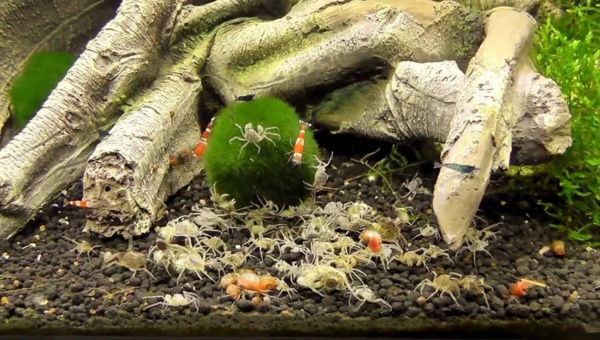
Some good tank mates for Thai Micro Crabs are:
- Cherry Shrimp: Cherry shrimp are small, colorful shrimp that make a great addition to any tank.
- Ghost Shrimp: Ghost shrimp are small, transparent shrimp perfect for keeping with Thai Micro Crabs.
- Ramshorn Snails: Ramshorn Snails are tiny, brown snails that scavenge the bottom of the tank for food.
- Malaysian Trumpet Snails: Malaysian trumpet snails are giant, colorful snails that scavenge the bottom of the tank for food.
- Kuhli Loach: Kuhli loaches are small, eel-like fish that love to swim in the open water.
- Bloodfin Tetra: Bloodfin tetras are small, colorful fish that school in the open water.
- Cherry Barb: Cherry barbs are small, colorful fish that school in the open water.
- Small fish: This includes small saltwater fish and freshwater fish.
- Hermit crabs: These make good tank mates for Thai Micro Crabs.
You should avoid keeping any aggressive fish or animals with Thai Micro Crabs, as they may harm the crabs. You should also avoid keeping invertebrates with the crabs, as they may prey on them.
Thai Micro Crab: Fish/Animals To Avoid
- Aggressive fish: These include other types of crabs, eels, and lionfish.
- Invertebrates: This includes crabs and snails.
You should consult a veterinarian if you are unsure what to put in your tank with your Thai Micro Crabs. You should be fine if you avoid putting aggressive fish or invertebrates in the tank.
Advantages Of Having Thai Micro Crab In Your Tank
The first advantage of having Thai Micro Crabs in your tank is that they are exciting to watch. They are active and playful, and they love to explore their environment. They are also very social and will socialize with their owners when given the opportunity.
Another advantage of having them in your tank is that they help clean the tank. They scavenge the bottom of the tank for food and help keep the water clean.
The final advantage is that they are low-maintenance pets. They require little care and can be left in the tank without problems.
Overall, Thai Micro Crabs make a great addition to your tank. They are fascinating to watch, help keep the tank clean, and are a good protein source. If you are unsuccessful in breeding them, you can always purchase them from a pet store.
Disadvantages Of Having Thai Micro Crab In Your Tank
The disadvantage of having Thai Micro Crabs in your tank is that they can be aggressive. They may harm other fish or animals in the tank, and they may also harm invertebrates.
Another disadvantage is that they can be challenging to breed. Getting them to breed successfully cannot be easy, and it may take a lot of patience. Also, their captive-bred babies do not survive a week.
Remember, you should consult a Professional Aquarist if you are unsure what to put in your tank with your Thai Micro Crabs. You should be fine if you avoid putting aggressive fish or invertebrates in the tank.
Conclusion
We hope this guide has helped you decide if a Thai Micro Crab is right for you! Please let us know what you think in the comments below. Are you thinking of adding one to your tank? What do you think about their advantages and disadvantages? We would love to hear from you!

